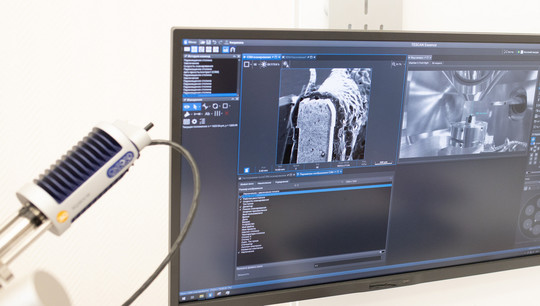Ural Federal University Experts Make New Material for Alternative Energy Sources
A new material for the creation of environmentally friendly alternative sources of electricity has been created by scientists from Ural Federal University and Ural Branch of the Russian Academy of Sciences. The development makes it possible to reduce time and resource costs for the production of fuel cells. The results of the study are published in the Journal of the European Ceramic Society.
Today, most wearable and portable electronic devices and electric vehicles, such as cell phones, laptops, electric scooters and bicycles, electric cars and electric vehicles, require constant recharging or replacement of the energy source.
Alkaline and acid batteries are widely used, but they contain harmful substances (e.g. lead in acid batteries, cadmium in alkaline batteries), so they cannot be simply thrown away, but must be recycled at special enterprises.
Lithium-ion batteries have a number of advantages, but they are explosive (because of which, for example, their transportation in airplanes is limited). In addition, lithium reserves in the Earth’s crust are limited and distributed very unevenly.An alternative to acid, alkaline and lithium-ion sources of electricity is fuel cell systems. These are current sources that convert chemical energy of fuel into electrical energy directly.
According to UrFU scientists, the class of solid oxide fuel cells (SOFC) is of the greatest interest. These are some of the most environmentally friendly power generators, have a fairly high ECE and make it possible to use different fuel compositions.
Researchers explained that the SOFC contain “plus” and minus”, which are produced with the usage of completely different technologies. To simplify the production of SOFC, scientists are designing symmetrical cells where both electrodes are identical in composition and can be produced using the same process scheme. They believe that this will reduce the cost of manufacturing and maintenance of SOFC and contribute to their widespread use.
The team of developers were financially supported by the Priority-2030 program. They synthesized and studied new compounds of the ferrite class to create symmetric SOFC based on iron, barium and lanthanum (La1-xBaxFeO3-δ, x = 0.4, 0.5, 0.6). The scientists investigated the structure, mechanical and electrical parameters of the synthesized materials, and also established the influence of some proton-conducting additives on their properties.
“The lanthanum-barium ferrite-based materials we obtained demonstrate high values of conductivity and low values of polarization resistances in air atmosphere, and these are the key characteristics of potential materials for SOFC,” said Dmitry Medvedev, Head of the Hydrogen Energy Laboratory at UrFU.
He noted that in many studies the stability of the characteristics of materials for symmetric fuel cells is assessed only in an oxidizing atmosphere, i.e. in the air atmosphere. But the UrFU researchers found that their composition is also stable in a reducing atmosphere, which is formed due to the use of hydrogen as a fuel in SOFC.
“We found that, all other things being equal, the most promising material for SOFC is La0.6Ba0.4FeO3-δ. It has the best conductivity and the lowest polarization, which helps to increase the power of fuel cells,” Medvedev explained.
In the future, the team plans to improve the characteristics of the compositions it has studied and create a full-size fuel cell for experimental studies.
The Research Institute of Hydrogen Energy is the base site for the implementation of the UrFU strategic project “Materials and Technologies for Hydrogen and Nuclear Energy” within the framework of the Russian state academic leadership program “Priority-2030”.

